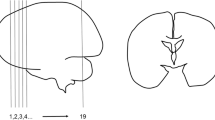Summary
In addition to ependymal epithelial cells, numerous tanycytes are found along the entire central canal of the mouse. These tanycytes are arranged in clusters in the cervical, thoracic and lumbar segments of the spinal cord. In the conus medullaris, tanycytes separate and ensheath bundles of myelinated and unmyelinated axons; their processes take part in the formation of the stratum marginale gliae. In the caudal part of the spinal cord, the ventral wall of the central canal is thin and some areas are reduced to a single-cell thickness. In this region, ependymal cells participate directly in the formation of the stratum marginale gliae.
The meninges consist of the intima piae, the pia mater, the arachnoid, a subdural neurothelium and the dura mater. The subarachnoid space appears occluded and opens only around the spinal roots. In the vicinity of the spinal ganglia, the dura mater, the subdural neurothelium and the arachnoid form a cellular reticulum.
Similar content being viewed by others
References
Andres KH (1966) Über die Feinstruktur der Hüllen des Nervensystems der Katze (Felis catus L.). Verh Anat Ges 61:483–487
Andres KH (1967a) Über die Feinstruktur der Arachnoidea und Dura mater von Mammalia. Z Zellforsch 79:272–295
Andres KH (1967b) Zur Feinstruktur der Arachnoidalzotten bei Mammalia. Z Zellforsch 82:92–109
Becker DP, Wilson JA, Watson GW (1972) The spinal cord central canal: response to experimental hydrocephalus and canal occlusion. J Neurosurg 36:416–424
Bradbury MWB, Lathem W (1965) A flow of cerebrospinal fluid along the central canal of the spinal cord of the rabbit and communications between this canal and the sacral subarachnoid space. J Physiol 181:785–800
Brightman MW, Reese TS (1969) Junctions between intimately apposed cell membranes in the vertebrate brain. J Cell Biol 40:648–677
Cloyd MW, Low FN (1974) Scanning electron microscopy of the subarachnoid space in the dog. I. Spinal cord levels. J Comp Neurol 153:325–368
Dohrmann GJ (1972) Cervical cord in experimental hydrocephalus. J Neurosurg 37:538–542
Eisenberg HM, McLennan JE, Welch K (1974) Ventricular perfusion in cats with kaolin-induced hydrocephalus. J Neurosurg 41:20–28 (1974)
Haller FR, Low FN (1971) The fine structure of the peripheral nerve root sheath in the subarachnoid space in the rat and other laboratory animals. Am J Anat 131:1–20
Haller FR, Haller AC, Low FN (1972) The fine structure of cellular layers and connective tissue space at spinal nerve root attachments in the rat. Am J Anat 133:109–124
Himango WA, Low FN (1971) The fine structure of a lateral recess of the subarachnoid space in the rat. Anat Rec 171:1–20
Horstmann E (1954) Die Faserglia des Selachiergehirns. Z Zellforsch 39:588–617
Kuwamura K, McLone DG, Raimondi AJ (1978) The central (spinal) canal in congenital murine hydrocephalus: morphological and physiological aspects. Child's Brain 4:216–234
Leonhardt H (1966) Über ependymale Tanyzyten des III. Ventrikels beim Kaninchen in elektronenmikroskopischer Betrachtung. Z Zellforsch 74:1–11
Leonhardt H (1980) Ependym und Circumventrikuläre Organe. In: Oksche A, Vollrath L (eds) Handbuch der mikroskopischen Anatomie des Menschen, Vol 4, part 10. Springer: Berlin Heidelberg New York, pp 177–666
Malloy JJ, Low FN (1974) Scanning electron microscopy of the subarachnoid space in the dog. II. Spinal nerve exits. J Comp Neurol 157:87–108
McLaurin RL, Bailey OT, Schurr PH, Ingraham FD (1954) Myelomalacia and multiple cavitations of spinal cord secondary to adhesive arachnoiditis. Arch Pathol Lab Med 57:138–146
McLone DG, Bondareff W (1975) Developmental morphology of the subarachnoid space and contiguous structures in the mouse. Am J Anat 142:273–294
Millhouse OE (1972) Light and electron microscopic studies of the ventricular wall. Z Zellforsch 127:149–174
Nabeshima S, Reese TS, Landis DMD, Brightman MW (1975) Junctions in the meninges and marginal glia. J Comp Neurol 164:127–170
Pilgrim Ch, Wagner H-J (1977) Zur Frage der Transportfunktion des Tanyzytenependyms. Nova Acta Leopol Suppl 9:69–74
Reynolds ES (1963) The use of lead citrate at high pH as an electron-opaque stain in electron microscopy. J Cell Biol 17:208–212
Seitz R, Schwendemann G, Löhler J (1980) Experimentelle Infektion der Maus mit dem Sendai-Virus (Parainfluenza I-Virus): Beteiligung von Rückenmark und Spinalganglien. Curr Top Neuropathol 6:61–75
Spurr AR (1969) A low-viscosity epoxy resin embedding medium for electron microscopy. J Ultrastruct Res 26:31–43
Sterba G, Naumann W (1966) Elektronenmikroskopische Untersuchungen über den Reissnerschen Faden und die Ependymzellen im Rückenmark von Lampetra planerii (Bloch). Z Zellforsch 72:516–524
Torvik A, Murthy VS (1977) The spinal cord central canal in kaolin-induced hydrocephalus. J Neurosurg 47:397–402
Waggener JD, Beggs J (1967) The membranous coverings of neural tissues: an electron microscopy study. J Neuropathol Exp Neurol 26:412–426
Wechsler W (1966) Elektronenmikroskopischer Beitrag zur Differenzierung des Ependyms am Rückenmark von Hühnerembryonen. Z Zellforsch 74:423–442
Author information
Authors and Affiliations
Rights and permissions
About this article
Cite this article
Seitz, R., Löhler, J. & Schwendemann, G. Ependyma and meninges of the spinal cord of the mouse. Cell Tissue Res. 220, 61–72 (1981). https://doi.org/10.1007/BF00209966
Accepted:
Issue Date:
DOI: https://doi.org/10.1007/BF00209966



